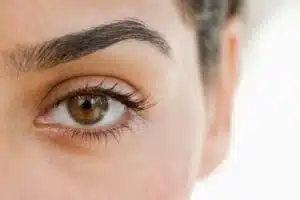Whether you are in your thirties or sixties, whether you have a pale complexion or darker skin, you are never immune to pigment spots! To better understand the phenomenon and the importance of protecting your skin, read on!
Different types of spots exist, which can appear in various shapes and colours all over your body. Some are hereditary in nature and have been present since birth, while others manifest over time based on a variety of factors.
WHAT CAUSES SPOTS?
Most spots are the result of skin hyperpigmentation. Brought about by excessive sun exposure, hormonal changes, genetic predisposition or skin trauma, hyperpigmentation occurs when the body’s melanocyte cells produce excessive amounts of melanin—the brown pigment that confers colour to skin. This excessive production of melanin builds up in certain localized areas and leads to the development of small spots on the skin surface that contrast in colour with the clearer, surrounding skin.
THE DIFFERENT TYPES OF SPOTS
• Brown spots (age spots, sun spots, lentigo…) are mainly caused by exposure to the sun’s ultraviolet rays. These spots vary in size, feature a darkish brown colour, and normally manifest in your fifties after many years of sun exposure.
• Freckles, also called skin sprinkles, appear in childhood as brownish or reddish borderless spots of varying size (1 to 5 mm). They are more common in individuals with fair complexions and blonde or red hair. Freckles are sensitive to ultraviolet rays and often turn darker during the summer but tend to fade over time.
• Café au lait spots are flat and vary in colour between light and dark brown. They can be oval or round and are usually present from birth, but can also form during the first year of life.
• Spots bearing the scientific name melasma (or “the mask of pregnancy”) are characterized by their grayish-brown discolouration on the face and are usually caused by intense hormonal activity during.
HOW TO PREVENT SPOTS
Even if you haven’t yet noticed the presence of brown spots on your skin, it is important to take a proactive approach with regard to harmful UV rays.
Prevention is key:
• Regularly apply sunscreen with an elevated SPF and prioritize exposed areas where spots tend to develop: the face, hands, décolleté, shoulders and arms;
• When exposed to sunlight, always wear a hat and clothing that keeps you properly covered (long sleeves, etc.);
• Avoid exposure to sunlight between 11 a.m. and 4 p.m.
Be vigilant :
It is strongly recommended that you monitor the evolution of your spots. If you notice a change in size, shape or colour, or if they bleed, you should consult a specialist as soon as possible so that a sample of your hyperpigmented cells can be taken and a full biopsy performed to eliminate all risk of melanoma
THE VARIOUS TREATMENTS
1 – Laser : Different types of fractional lasers can help improve skin discolouration problems. The basic principle behind all lasers is the same: the energy contained in the light beam creates superficial microscopic lesions on the skin that stimulate it to repair itself. The newly generated skin cells help create a skin tone that looks more uniform.
The type of laser used depends on the colour of the skin and the type of spot to be treated. Improvement can usually be seen after a few sessions.
To know more
2 – Pulsed Light : The pulsed light platform used by Dermapure helps correct blemishes such as pigment spots while also diminishing certain vascular disorders. The pulsed light seeks out colour contrasts beneath the skin to dry out and eliminate the visible, small brown or red spots.
To know more
3 – Glycolic Acid Peel : A depigmenting product with natural fruit acid base—with varying concentrations depending on need—is applied to hyperpigmented skin to exfoliate problem cells. While this treatment remains superficial, a skin-brightening effect can be seen as part of a course of several treatments.
To know more
4 – Diamond Microdermabrasion : A small tip covered with fine diamond crystals is used to mechanically abrade the skin surface and remove a portion of dead skin on the stratum corneum to stimulate skin to renew itself. This basic rejuvenating treatment reduces the appearance of spots on the skin surface.
To know more
Assessing your overall health and skin type is an important first step before any type of treatment can be recommended for eliminating or reducing the appearance of spots. Our specialists can provide you with the right guidance during your free consultation.
Remember: correction is an option, prevention is a must!






